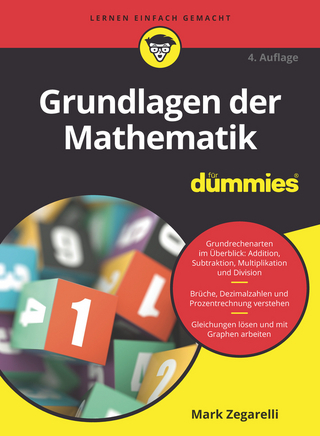
Mathematics and Statistics for Science
Springer International Publishing (Verlag)
978-3-031-05317-7 (ISBN)
Beginning with the use of units and functions, this book covers key topics such as complex numbers, vectors and matrices, differentiation (both single and multivariable), integration, elementary differential equations, probability, random variables, inference and linear regression. Each topic is illustrated with widely-used scientific equations (such as the ideal gas law or the Nernst equation) and real scientific data, often taken directly from recent scientific papers. The emphasis throughout is on practical solutions, including the use of computational tools (such as Wolfram Alpha or R), not theoretical development. There is a large number of exercises, divided into mathematical drills and scientific applications, and full solutions to all the exercises are available to instructors.
Mathematics and Statistics for Science covers the core methods in mathematics and statistics necessary for a university degree in science, highlighting practical solutions and scientific applications. Its pragmatic approach is ideal for students who need to apply mathematics and statistics in a real scientific setting, whether in the physical sciences, life sciences or medicine.
James Sneyd is a Professor of Applied Mathematics at the University of Auckland, New Zealand. His research is mostly in mathematical physiology and cell biology, and he is the co-author (with Jim Keener) of the prize-winning book Mathematical Physiology. He lives beside a beach, and it is absolutely untrue that he would ever waste his time playing computer games. Rachel Fewster is a Professor of Statistics at the University of Auckland, New Zealand. She has over 20 years experience of teaching mathematical statistics to students with diverse interests, for which she has received a national tertiary educator award. She is a leading researcher in statistical methods for wildlife conservation, and has pioneered numerous methods for analysing novel data types generated by emerging technologies for remote sensing and animal recognition. She leads a large citizen science project for New Zealand community conservationists and enjoys the challenge of communicating technical information to diverse audiences in an engaging and accessible manner. She is a recipient of the Campbell Award, the premier award for New Zealand statisticians. Duncan McGillivray is a Professor of Physical Chemistry at the University of Auckland, New Zealand, and a Fellow of the Royal Society of Chemistry and the New Zealand Institute of Chemistry. He uses a wide range of mathematical tools in his studies of biologically relevant colloids and interfaces using neutron scattering. He is passionate about teaching and learning for science students, and has been involved in teaching at all levels of tertiary study.
Part I Units and Measurement.- 1 Units.- 2 Measurement, rounding and uncertainty.- Part II Functions and Complex Numbers.- 3 Functions.- 4 Exponential and log functions.- 5 Periodic functions.- 6 Linearising functions.- 7 Complex numbers.- Part III Vectors, Matrices and Linear Systems.- 8 Vectors.- 9 Matrices.- 10 Systems of linear equations.- 11 Solving systems of linear equations using matrices.- Part IV Differentiation: Functions of One Variable.- 12 Limits.- 13 Differentiation as a limit.- 14. Differentiation in practice.- 15 Numerical differentiation.- 16 Implicit differentiation.- 17 Maxima and minima.- Part V Differentiation: Functions of Multiple Variables.- 18 Functions of multiple variables.- 19 Partial derivatives.- 20 Extreme of functions of two (or more) variables.- Part VI Integration.- 21 The area under a curve.- 22 Calculating antiderivatives and areas.- 23 Integration techniques.- 24 Numerical integration.- Part VII Differential Equations.- 25 First-order ordinary differential equations.- 26 Numerical solutions of differential equations.- Part VIII Probability.- 27 Probability foundations.- 28 Random variables.- 29 Binomial distribution.- 30 Conditional probability.- 31 Total probability rule.- Part IX Statistical inference.- 32 Hypothesis test.- 33 Hypothesis testing in practice.- 34 Estimation and likelihood.- Part X Discrete Probability Distributions.- 35 Simulation and visualisation.- 36 Mean.- 37 Variance.- 38 Discrete probability models.- Part XI Continuous Probability Distributions.- 39 Continuous random variables.- 40 Common continuous probability models.- 41 Normal distribution and inference.- Part XII Linear Regression.- 42 Fitting linear functions: theory and practice.- 43 Quantifying relationships.- References.- Index.
| Erscheinungsdatum | 01.07.2022 |
|---|---|
| Zusatzinfo | XVI, 964 p. 360 illus., 321 illus. in color. |
| Verlagsort | Cham |
| Sprache | englisch |
| Maße | 178 x 254 mm |
| Gewicht | 2373 g |
| Themenwelt | Mathematik / Informatik ► Mathematik ► Allgemeines / Lexika |
| Mathematik / Informatik ► Mathematik ► Angewandte Mathematik | |
| Mathematik / Informatik ► Mathematik ► Statistik | |
| Schlagworte | Applications of mathematics to science • Applications of statistics to science • Calculus for science • Computational methods for calculus • Linear algebra for science • Mathematical methods for science • Mathematics for biology • Mathematics for chemistry • Mathematics for medicine • Probability for science • Scientific applications of mathematics • Scientific applications of statistics • Statistics for biology • Statistics for chemistry • statistics for medicine |
| ISBN-10 | 3-031-05317-6 / 3031053176 |
| ISBN-13 | 978-3-031-05317-7 / 9783031053177 |
| Zustand | Neuware |
| Haben Sie eine Frage zum Produkt? |
aus dem Bereich


